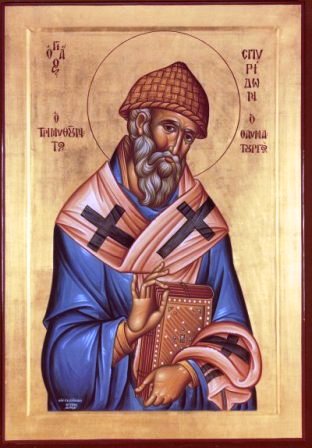|
|
St Spiridon the Wonderworker, Bishop of Tremithus The island of Cyprus was both the birthplace of this famous saint, and the place in which he spent his life in the service of the Church. He was of simple farming stock, and remained simple and humble to the end of his days. He married young and had children, but, when his wife died, he devoted himself entirely to the service of God. He was chosen for his devotion as Bishop of Tremithus, and even as a bishop did not change his simple style of life, taking charge of his cattle himself and tilling his own land. He consumed very little of his own produce, giving the greater part to the poor. He performed great wonders by God"s power, making rain fall in a drought, stopping the course of a river, raising several of the dead, healing the Emperor Constans of a grave sickness, seeing and hearing angels, foreseeing future events and penetrating the secrets of the human heart. He turned many to the true Faith, and did much else. He was present at the first Ecumenical Council in Nicaea in 325, and, by his simple and clear expositions of the Faith, as well as by convincing miracles, brought back many heretics to Orthodoxy. He dressed so simply that once, when he was invited by the Emperor to the imperial court, a soldier took him for a beggar and struck him a blow. The meek and guileless Spiridon turned him the other cheek. He glorified God with many miracles, and was of great aid both to individuals and to the whole Church of God. He entered into rest in the Lord in 348, and his wonderworking relics now lie on the island of Corfu and continue to glorify God with many wonders. The island of Cyprus was both the birthplace of this famous saint, and the place in which he spent his life in the service of the Church. He was of simple farming stock, and remained simple and humble to the end of his days. He married young and had children, but, when his wife died, he devoted himself entirely to the service of God. He was chosen for his devotion as Bishop of Tremithus, and even as a bishop did not change his simple style of life, taking charge of his cattle himself and tilling his own land. He consumed very little of his own produce, giving the greater part to the poor. He performed great wonders by God"s power, making rain fall in a drought, stopping the course of a river, raising several of the dead, healing the Emperor Constans of a grave sickness, seeing and hearing angels, foreseeing future events and penetrating the secrets of the human heart. He turned many to the true Faith, and did much else. He was present at the first Ecumenical Council in Nicaea in 325, and, by his simple and clear expositions of the Faith, as well as by convincing miracles, brought back many heretics to Orthodoxy. He dressed so simply that once, when he was invited by the Emperor to the imperial court, a soldier took him for a beggar and struck him a blow. The meek and guileless Spiridon turned him the other cheek. He glorified God with many miracles, and was of great aid both to individuals and to the whole Church of God. He entered into rest in the Lord in 348, and his wonderworking relics now lie on the island of Corfu and continue to glorify God with many wonders.The Hieromartyr Alexander, Bishop of Jerusalem He was at first bishop in Cappadocia, but, during the persecution under Severus in 203, was thrown into prison and then exiled. After that, he accepted the see of Jerusalem, and there founded a famous library that was of great use to Eusebius when he was writing his Ecclesiastical History. He was tortured in various ways during the reign of Decius, and was thrown to the wild beasts. Alive and unharmed, he was cast back into prison, where he finished his earthly course and went to the Lord in the year 251. He was at first bishop in Cappadocia, but, during the persecution under Severus in 203, was thrown into prison and then exiled. After that, he accepted the see of Jerusalem, and there founded a famous library that was of great use to Eusebius when he was writing his Ecclesiastical History. He was tortured in various ways during the reign of Decius, and was thrown to the wild beasts. Alive and unharmed, he was cast back into prison, where he finished his earthly course and went to the Lord in the year 251.The Holy Martyr SynesiusHe boldly preached the truth of Christ as a young reader in Rome, and denounced the idolaters. He was beheaded for his outspokenness during the reign of Aurelian, towards the end of the third century.
|